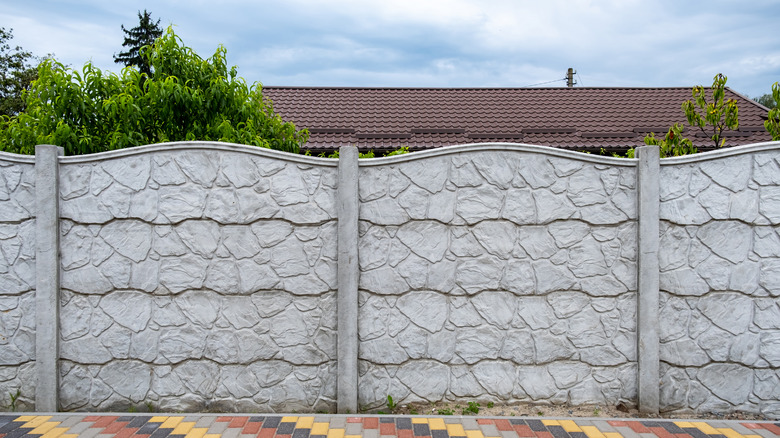What To Consider Before Installing A Masonry Fence In Your Backyard
When you want to add some privacy for your home's backyard while improving the property's aesthetics, adding a fence is an easy choice. However, determining what style of fence your home needs requires a bit more thought. Some popular types of fencing include wood, vinyl, and chain link.
However, another type of popular fence that can give your property a significantly upgraded look is one made of masonry. The masonry fence consists of stone, brick, or concrete blocks secured with mortar. Building a stone fence can take several days and is considered a labor-intensive, complex job for a DIYer. Anyone trying to construct a brick or stone design themselves should have basic masonry skills and an understanding of how to follow local building code regulations. You might need to hire a professional mason to ensure a safe installation that's made to last. Handling stone can be a dangerous job that subjects DIYers to potential crushing injuries. If your brick fence will be more than 7 feet in height, you'll have to provide extra support structures to maintain its sturdiness and reduce the risk of it falling.
Beyond the challenges associated with DIYing a masonry fence, what else should you know about this type of structure before deciding whether to build one? Learn some tips for building the perfect fence from masonry and the pros and cons of using this material.
Benefits of constructing a masonry fence for your house
If you want a type of fencing that will last as long as you'll be in your house — and probably longer — masonry fences are the right choice, as they can last for hundreds of years. Unlike some other common fencing materials, brick and stone are resistant to rot or pests, which plays a significant role in the longevity they offer. Stone and brick have many centuries of history behind them as effective options for building fencing in locations throughout the world, making them proven materials that deliver a sense of strength and permanence for your property. You can even add wood or metal to these materials to create a pleasing design in a hybrid fence.
Another big benefit of a masonry fence is that it provides privacy and sound protection. Brick or stone covered with stucco is an effective design for reducing noise from neighbors, industrial areas, or busy roads.
The improved aesthetic you receive by adding a masonry fence to your property is significant, especially if you live in an older home that has a stately design. Additionally, brick and stone are available in a variety of color shades, meaning you can select colors that complement the paint color and design of your house's exterior. When built correctly, stone and brick fences are also likely to increase your property value because homebuyers appreciate the look they offer. A sturdy masonry fence might even lower your homeowners' insurance costs, especially in areas that frequently have stormy weather.
Reasons why you might want to skip building a masonry fence
Brick and stone fences may deliver increased home value and aesthetics, but you'll have to pay quite a bit for them because they're far more expensive than other fencing materials. You can expect to pay between $15 and $40 per square foot for a brick fence, while stone may cost from $45 to as much as $200 per square foot, although the average cost is about $125 per square foot. (If you want to save a bit of money, you might be able to recycle old brick pavers for a fencing project.)
Even though a masonry fence is highly durable, it still requires regular maintenance. If the ground underneath the fencing shifts from issues like frost heave, the stone, brick, or mortar might crack or buckle, reducing the stability. Other fencing materials aren't as rigid as masonry, allowing them to shift with any slight movement of the ground. Inspect the mortar and materials for cracks, crumbling, or missing sections at least once a year. When damage does occur to a stone or brick fence, you might have to redo an entire section, which can be pricey.
Although improved aesthetics is a benefit of masonry, some people do not like the industrial aesthetic associated with these materials. However, if the building features brick in the construction, brick fencing is considered a complementary option. If you select a stone fence, select a type of stone that complements your home's style among the various options like granite, limestone, sandstone, and slate.
How masonry compares to using other common fencing materials
Wood is a popular material to use with fencing, but it doesn't have the longevity that matches masonry materials. Masonry fences can last hundreds of years, while wood will provide a couple decades of longevity. Wood materials require painting or staining every couple of years, too. Sun and weather exposure can cause the paint or stain to fade and peel. Wood's primary advantage compared to a stone or brick fence is cost, as a wood fence costs about $14 to $35 per linear foot to install, while brick and stone fences typically cost a lot more, possibly getting into hundreds of dollars per linear foot.
Compared to another popular type of fencing – chain link – masonry is far better at blocking sound and providing privacy for your home. Because the chain link design is open, it doesn't provide privacy or block sound unless you cover it with decorative panels or inserts. Masonry fencing materials will deliver an impressive aesthetic appeal for your property because of the natural beauty of stone and brick. A chain link design, meanwhile, doesn't have much aesthetic appeal, meaning you may have to paint it, add coverings, or plant vines near it to boost its aesthetic appeal. As its primary advantage compared to masonry fencing, chain link is far cheaper, as chain link costs $8 to $40 per linear foot to install.



